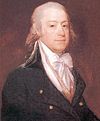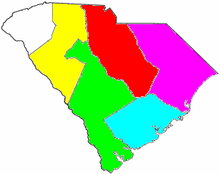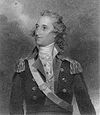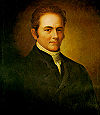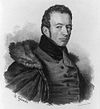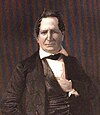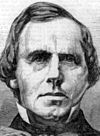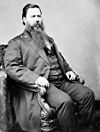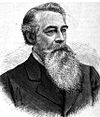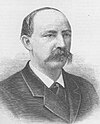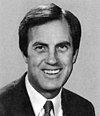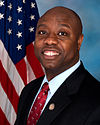| South Carolina's 1st congressional district | |
|---|---|
 Interactive map of district boundaries since January 3, 2023 Interactive map of district boundaries since January 3, 2023 | |
| Representative | Nancy Mace R–Charleston |
| Population (2023) | 776,842 |
| Median household income | $89,127 |
| Ethnicity |
|
| Cook PVI | R+7 |
South Carolina's 1st congressional district is a coastal congressional district in South Carolina, represented by Republican Nancy Mace since January 3, 2021. She succeeded Democrat Joe Cunningham, having defeated him in the 2020 election. Cunningham was the first Democrat to represent the district since the 1980s.
The district has historically been based in Charleston. It has included Myrtle Beach, which became a major tourist destination in the late 20th century, as well as other coastal areas that have attracted retirees and seasonal visitors. From 1993 to 2013, the district boundaries extended from Seabrook Island in the south to the North Carolina border and included parts of Charleston, Dorchester, Berkeley and Georgetown counties and all of Horry County to the North Carolina line.
In 2010, the state received another seat in Congressional apportionment due to an increase in population. The state's districts had to be redrawn, which was completed in 2013. In the final plan, the 1st congressional district was redrawn to reach from Hilton Head Island to mid-coast South Carolina, ending at the Santee River and comprising parts of Charleston, Berkeley, Dorchester and Beaufort counties. This configuration is similar to the one it had for most of the 20th century. Horry County was included in the new 7th congressional district.
On January 6, 2023, the district was declared unconstitutional by the U.S. District Court for the District of South Carolina on account of racial gerrymandering and would have to be redrawn in April of that year. The Supreme Court justices added Alexander v. South Carolina State Conference of the NAACP to their merits calendar for the 2023–24 term. At least fifteen amicus briefs were filed by various organizations and individuals with standing before the court. The case was argued on October 11, 2023. On March 28, 2024, the same district court that ruled the congressional district was unconstitutional, allowed for its use in the 2024 elections. It concluded that it would be impractical to create a new district map at the current time, mainly due to the upcoming military and overseas ballot mailing deadline of April 27 and statewide primaries on June 11. However, it still found the district to be in violation of the 14th amendment and believed future litigation is possible after the 2024 elections.
On May 23, 2024, the Supreme Court—in a 6–3 decision—ruled the district was constitutional, reversing the District of South Carolina's original ruling and officially allowing the state's current congressional map to be used for and past the 2024 elections. It also remanded the case back to the district court to rehear other claims made by the defendants.
It is the wealthiest congressional district in the state of South Carolina.
History
Following the Civil War and granting of citizenship to former slaves, in 1870, Charleston's population was 53 percent black; and Charleston County had a 73 percent black majority. The city's large population of free people of color had developed many leaders who advanced in the changing society. These population majorities protected freedmen against some of the election-related violence that occurred in other parts of the state in the 1870s as white Democrats worked to suppress black voting and regain political control of the state. During Reconstruction, the mostly black Republicans from this district supported Republican candidates, including four terms for Joseph H. Rainey as US Representative to Congress, a record by an African-American legislator not surpassed until the 1950s.
After the Democrats regained control of the state in 1876, during an election season marked by violence and fraud, and Reconstruction ended in 1877, they passed laws establishing racial segregation and making voter registration and voting more difficult, such as the "eight-box law". African-American George W. Murray finally won in the disputed 1894 congressional election from this district; he challenged the Republican candidate's victory because of election fraud and was upheld by the House Committee on Elections. But passage of a new state constitution by Democrats in 1895 effectively disfranchised most African-American citizens in 1896. Their participation in the political system was ended for seven decades. The white Democrats established a one-party state and used various devices to maintain the exclusion of blacks until after passage of federal civil rights legislation in the mid-1960s.
Party realignments in the late 20th century resulted in many new black voters supporting the national Democratic Party. White conservatives in the South shifted and joined the Republican Party, in 1980 electing the first Republican congressman from the state to be elected in the 20th century. Since the buildup of the military in this region, especially the Navy, the area's white voters have supported conservative candidates.
Given the crippling of the Republican Party by the disfranchisement of blacks, a Republican was not elected to a full term in this district in the 20th century until 1980, when Tommy Hartnett was swept in by Reagan's coattails. But, his election represented a different party and was the result of a major realignment of white conservative voters in the late 20th century to the Republican, rather than the Democratic Party. Starting with national candidates in the late 1960s and 1970s, white voters in South Carolina began to shift to the Republican Party.
As after every decennial census, the state legislature conducted redistricting after the 1990 census. The white Republican-controlled legislature shifted most of Charleston's African-American majority areas into South Carolina's 6th congressional district, creating a majority-minority district. To make up for the loss of population, the 1st was extended all the way up the Atlantic coast to Myrtle Beach. The 2010 redistricting cut the district back to the southeastern corner of the state.
Since that time, the 1st congressional district has had a majority-white population. But, in 2008, with the appeal of the Barack Obama presidential campaign, Democrat Linda Ketner came within two points of winning the 1st district congressional seat. In the following off-year election of 2010, Republican Tim Scott won the seat with 65 percent of the vote.
During the 2018 South Carolina primaries on June 12, 2018, Mark Sanford lost re-nomination to the seat. The Republicans would go on to lose the seat to the Democrats after the district swung heavily to the Democrats in the 2018 midterm elections.
2013 special election
Main article: 2013 South Carolina's 1st congressional district special electionTim Scott, a Republican from North Charleston, was elected as the 1st district's representative in 2010. He resigned after he was appointed by Governor Nikki Haley to the United States Senate when Jim DeMint resigned on January 1, 2013.
The district boundaries had been redrawn in 2011. A special election was held on May 7, 2013 to fill the vacancy created by Scott's resignation. In a Primary Election held on March 19, 2013, Elizabeth Colbert-Busch, the sister of comedian Stephen Colbert, won the Democratic nomination. Former Governor Mark Sanford, who represented the district from 1995 to 2001, and former Charleston County Councilman Curtis Eilliott Bostic faced each other in a runoff Primary for the Republican nomination on April 2, 2013. Sanford won the nomination, and defeated challengers Colbert-Busch and South Carolina Green Party candidate Eugene Platt in the special election on May 7.
Counties
Counties in the 2023–2033 district map:
- Beaufort County
- Berkeley County
- Charleston County (part)
- Colleton County (part)
- Dorchester County (part)
- Jasper County (part)
Recent election results from statewide races
| Year | Office | Results |
|---|---|---|
| 2008 | President | McCain 56% - 43% |
| 2012 | President | Romney 59% - 41% |
| 2016 | President | Trump 55% - 40% |
| Senate | Scott 65% - 33% | |
| 2018 | Governor | McMaster 53% - 47% |
| Secretary of State | Hammond 57% - 43% | |
| Treasurer | Loftis 56% - 41% | |
| Attorney General | Wilson 54% - 44% | |
| 2020 | President | Trump 53% - 45% |
| Senate | Graham 54% - 45% | |
| 2022 | Senate | Scott 62% - 38% |
| Governor | McMaster 55% - 44% | |
| Secretary of State | Hammond 62% - 38% | |
| Treasurer | Loftis 78% - 22% |
List of members representing the district
Past election results
2012
| Party | Candidate | Votes | % | |
|---|---|---|---|---|
| Republican | Tim Scott | 179,908 | 62.0 | |
| Democratic | Bobbie G. Rose | 103,557 | 35.7 | |
| Libertarian | Keith Blandford | 6,334 | 2.2 | |
| Write-in | 214 | 0.1 | ||
| Total votes | 290,013 | 100.0 | ||
| Republican hold | ||||
2013 special election
| Party | Candidate | Votes | % | |
|---|---|---|---|---|
| Republican | Mark Sanford | 77,600 | 54.03% | |
| Democratic | Elizabeth Colbert Busch | 64,961 | 45.22% | |
| Green | Eugene Platt | 690 | 0.48% | |
| Write-in | 384 | 0.27% | ||
| Total votes | 143,635 | 100.00% | ||
| Republican hold | ||||
2014
| Party | Candidate | Votes | % | |
|---|---|---|---|---|
| Republican | Mark Sanford (incumbent) | 119,392 | 93.4 | |
| Write-in | 8,423 | 6.6 | ||
| Total votes | 127,815 | 100.0 | ||
| Republican hold | ||||
2016
| Party | Candidate | Votes | % | |
|---|---|---|---|---|
| Republican | Mark Sanford (incumbent) | 190,410 | 58.6 | |
| Democratic | Dimitri Cherny | 119,779 | 36.8 | |
| Libertarian | Michael Grier Jr. | 11,614 | 3.6 | |
| American | Albert Travison | 2,774 | 0.8 | |
| Write-in | 593 | 0.2 | ||
| Total votes | 325,170 | 100.0 | ||
| Republican hold | ||||
2018
| Party | Candidate | Votes | % | |||
|---|---|---|---|---|---|---|
| Democratic | Joe Cunningham | 145,455 | 50.6 | |||
| Republican | Katie Arrington | 141,473 | 49.2 | |||
| Write-in | 505 | 0.2 | ||||
| Total votes | 287,433 | 100.0 | ||||
| Democratic gain from Republican | ||||||
2020
| Party | Candidate | Votes | % | |||
|---|---|---|---|---|---|---|
| Republican | Nancy Mace | 216,042 | 50.6 | |||
| Democratic | Joe Cunningham (incumbent) | 210,627 | 49.3 | |||
| Write-in | 442 | 0.1 | ||||
| Total votes | 427,111 | 100.0 | ||||
| Republican gain from Democratic | ||||||
2022
| Party | Candidate | Votes | % | |
|---|---|---|---|---|
| Republican | Nancy Mace (incumbent) | 153,757 | 56.3 | |
| Democratic | Annie Andrews | 115,796 | 42.4 | |
| Alliance | Joseph Oddo | 2,634 | 0.9 | |
| Total votes | 272,681 | 100.0 | ||
| Republican hold | ||||
2024
| Party | Candidate | Votes | % | |
|---|---|---|---|---|
| Republican | Nancy Mace (incumbent) | 227,235 | 58.3 | |
| Democratic | Michael B. Moore | 162,330 | 41.7 | |
| Total votes | 389,565 | 100.0 | ||
| Republican hold | ||||
See also
Notes
- Supported the Jackson faction in the 1824 United States presidential election.
- The votes for the Democratic candidate includes votes cast for the candidate who also ran under the Working Families Party ticket.
- Tim Scott resigned his seat in the 112th and 113th Congresses effective January 2, 2013, in order to be appointed to the United States Senate in place of Senator Jim DeMint, who resigned. As a result, the seat for the 1st congressional district was vacant from the onset of the 113th Congress.
References
- ^ "My Congressional District". census.gov. U.S. Census Bureau Center for New Media and Promotion (CNMP).
- "2022 Cook PVI: District Map and List". Cook Political Report. July 12, 2022. Retrieved August 30, 2022.
- Renaud, Tim (January 6, 2023). "South Carolina's 1st Congressional District was racially gerrymandered and must be redrawn, federal judges decide". WBTW. Retrieved January 9, 2023.
- "Talks on Alexander v SC State NAACP Amicus Briefs, case before US Supreme Court on October 11, now available online". League of Women Voters of South Carolina. October 8, 2023. Retrieved October 15, 2023.
- Montellaro, Zach (May 15, 2023). "Supreme Court to hear racial redistricting case from South Carolina". Politico. Retrieved September 13, 2023.
- "Alexander v. South Carolina Conference of the NAACP Oral Argument". C-SPAN. October 11, 2023. Retrieved October 15, 2023.
- Quinn, Melissa (March 28, 2024). "Federal court reinstates lines for South Carolina congressional district despite racial gerrymander ruling". CBS News. Retrieved March 28, 2024.
- Greenberg, Madeleine (March 28, 2024). "South Carolina Will Use Gerrymandered Congressional Map in 2024, District Court Rules". Democracy Docket. Retrieved March 28, 2024.
- Herlihy, Brianna; Mears, Bill (May 23, 2024). "Supreme Court upholds GOP-drawn voting map in South Carolina gerrymandering case". Fox News. Retrieved May 23, 2024.
- Sherman, Mark (May 23, 2024). "Supreme Court finds no bias against Black voters in a South Carolina congressional district". AP News. Retrieved October 14, 2024.
- Totenberg, Nina (May 23, 2024). "The Supreme Court rules in favor of South Carolina Republicans in voting map case". NPR. Retrieved October 14, 2024.
- Liptak, Adam (May 23, 2024). "Supreme Court Sides With Republicans Over South Carolina Voting Map". The New York Times. Retrieved May 23, 2024.
- Andrew DePietro (October 1, 2024). "The Richest Congressional Districts In Every State Of 2024". Forbes.
- ^ Melinda Meeks Hennessy, "Racial Violence During Reconstruction: The 1876 Riots in Charleston and Cainhoy", South Carolina Historical Magazine, Vol. 86, No. 2, (April 1985), 104-106 (subscription required)
- https://davesredistricting.org/maps#viewmap::839561a1-8c15-4c4b-ab56-3275d68092f9
- "South Carolina". Official Congressional Directory. 1991/1992- : S. Pub.: 103 1887. hdl:2027/uc1.l0075858456.
- "Election Statistics - US House of Representatives: History, Art & Archives". Karen Haas, Clerk of the United States House of Representatives. Retrieved February 23, 2013.
- "Statewide Results". South Carolina Dept. Of Elections. Retrieved May 8, 2013.
- "South Carolina Election Commission Official Results". West Virginia Secretary of State. November 4, 2014. Retrieved January 8, 2015.
- "2016 Statewide General Election official results". South Carolina State Election Commission. Retrieved December 5, 2016.
- Johnson, Cheryl L. (February 28, 2019). "Statistics of the Congressional Election of November 6, 2018". Clerk of the U.S. House of Representatives. Retrieved April 27, 2019.
- "2020 Statewide General Election Night Reporting - Results". South Carolina Election Commission. November 10, 2020. Retrieved November 11, 2020.
- "2022 Statewide General Election". www.enr-scvotes.org. November 11, 2022. Retrieved January 2, 2023.
- "Nancy Mace coasts to third term in Congress, solidifying GOP hold on House seat in SC". www.postandcourier.com. November 5, 2024. Retrieved November 7, 2024.
- Martis, Kenneth C. (1989). The Historical Atlas of Political Parties in the United States Congress. New York: Macmillan Publishing Company.
- Martis, Kenneth C. (1982). The Historical Atlas of United States Congressional Districts. New York: Macmillan Publishing Company.
- Congressional Biographical Directory of the United States 1774–present
| South Carolina's congressional districts | |
|---|---|
|
33°09′N 79°42′W / 33.15°N 79.70°W / 33.15; -79.70
Category: